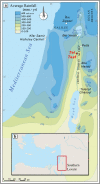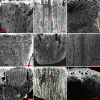7000-year-old evidence of fruit tree cultivation in the Jordan Valley, Israel
- PMID: 35523827
- PMCID: PMC9076912
- DOI: 10.1038/s41598-022-10743-6
7000-year-old evidence of fruit tree cultivation in the Jordan Valley, Israel
Abstract
This study provides one of the earliest examples of fruit tree cultivation worldwide, demonstrating that olive (Olea europaea) and fig (Ficus carica) horticulture was practiced as early as 7000 years ago in the Central Jordan Valley, Israel. It is based on the anatomical identification of a charcoal assemblage recovered from the Chalcolithic (7200-6700 cal. BP) site of Tel Tsaf. Given the site's location outside the wild olive's natural habitat, the substantial presence of charred olive wood remains at the site constitutes a strong case for horticulture. Furthermore, the occurrence of young charred fig branches (most probably from pruning) may indicate that figs were cultivated too. One such branch was 14C dated, yielding an age of ca. 7000 cal. BP. We hypothesize that established horticulture contributed to more elaborate social contracts and institutions since olive oil, table olives, and dry figs were highly suitable for long-distance trade and taxation.
© 2022. The Author(s).
Conflict of interest statement
The authors declare no competing interests.
Figures





References
-
- Garfinkel Y, Ben-Shlomo D, Kuperman T. Large-scale storage of grain surplus in the sixth millennium BC: The silos of Tel Tsaf. Antiquity. 2009;83:309–325. doi: 10.1017/S0003598X00098458. - DOI
-
- Rosenberg D, Garfinkel Y, Klimscha F. Large-scale storage and storage symbolism in the Ancient Near East—a unique clay model of a silo from Tel Tsaf, Israel. Antiquity. 2017;91:885–900. doi: 10.15184/aqy.2017.75. - DOI
-
- Ben-Shlomo D, Hill AC, Garfinkel Y. Feasting between the revolutions: Evidence from chalcolithic Tel Tsaf, Israel. J. Mediterr. Archaeol. 2009;22:129–150.
-
- Garfinkel Y, Ben-Shlomo D, Freikman M, Vered A. Tel Tsaf: The 2004–2006 excavation seasons. Isr. Explor. J. 2007;57:1–33.
-
- Freikman M, Garfinkel Y. Sealings before cities: New evidence on the beginnings of administration in the Ancient Near East. Levant. 2017;49:1–22. doi: 10.1080/00758914.2017.1323290. - DOI
Publication types
MeSH terms
LinkOut - more resources
Full Text Sources

